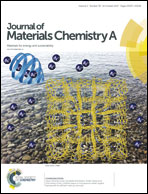Facile fabrication of freestanding all-carbon activated carbon membranes for high-performance and universal pollutant management†
Abstract
Freestanding all-carbon activated carbon membranes (ACMs) were fabricated for the first time in an environmentally friendly manner using reduced graphene oxide (rGO) as a coupling agent for activated carbon particles. Due to the tunable noncovalent π–π interactions between the AC particles and rGO nanosheets, the ACMs not only displayed unique chemical and thermal stabilities but also had controllable pore sizes over a wide range, from microns to nanometers, and could be applied to pollutant management in both water and organic solvents. The powerful adsorption capability of activated carbon was well preserved in the ACMs. The ACMs can exclude micrometer and nanometer particles (such as bacteria, silica nanoparticles and silver nanoparticles) with 100% removal efficiency; adsorb dissolved pollutants with an excellent saturation capacity of 7.7 mg g−1 for Ag+, 235.2 mg g−1 for methylene blue, and higher than 410 mg g−1 for phenanthrene; and simultaneously remove multiple pollutants from both water and organic solvents through a one-step filtration process while maintaining high water flux. The ACM surfaces possess high surface energy and exhibit superhydrophilic properties. Thus, the novel ACMs, with combined sieving and adsorption properties, have great potential for universal pollutant management and industrial chemical separation.



 Please wait while we load your content...
Please wait while we load your content...